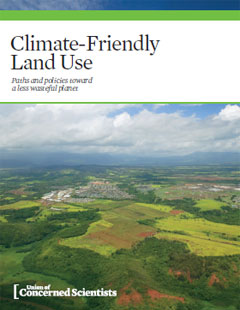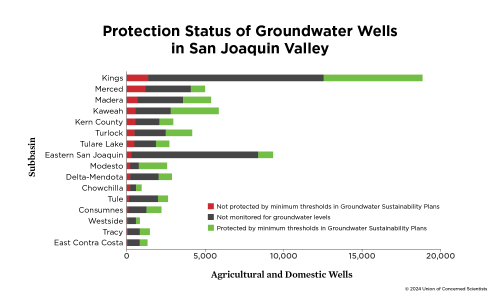Tremendous waste is built into the way we utilize the world's land.
Inefficiencies in our land use practices not only limit the amount of food we produce, they also have far-reaching consequences for our health, our environment, and the global climate.
One of the key drivers of this waste is changing patterns of consumption, especially the rising global demand for beef. To create a healthier and more productive planet — and to reduce the heat-trapping emissions that cause global warming — we need smart policies that shift consumption and land use patterns in less wasteful directions.
Current agricultural land use, especially beef production, is wasteful and generates substantial global warming emissions
- Producing meat requires large tracts of land and substantial biomass for feed, and is a less efficient food source than plants — and beef is the least efficient meat by far.
- Beef represents only a small part of humanity's food — less than 5 percent of the protein and under 2 percent of the calories — yet its cost, whether in terms of land, crops for feed, or global warming emissions, is much higher than other food sources.
- Producing a ton of beef requires approximately 20 times more land on average than an equal amount of chicken or pork.
- Worldwide, cattle and other livestock consume more than six billion tons of biomass annually, versus less than one billion ton for chicken and pigs, yet the amount of food produced is practically the same.
- Global warming emissions from beef production are also much higher than other meat: 45 - 643 kilograms of carbon dioxide equivalent (CO2e) per kilogram of protein, versus 20 - 55 for pork and 10 - 30 for poultry meat.
Land use practices for producing palm oil, bioenergy, and wood products also create substantial inefficiencies
- The oil palm is a highly productive tree crop that grows well on abandoned land and can sequester substantial amounts of carbon if grown in these areas. But recent rapid growth in palm oil production has instead led to a substantial increase in carbon emissions as tropical forests are cleared for new palm oil plantations.
- Growing crops for bioenergy production, whether for electric power or biofuels, has the potential to compete with food production and create indirect land use effects that lead to global warming emissions in other regions or countries.
- Using natural forests, as opposed to secondary forests or tree plantations, for wood products represents another source of inefficiency. For example, tropical plantations are estimated to produce from three to ten times as much commercially valuable wood per hectare as mature natural forests.
Changes in global diets are a major driver of waste, inefficiency, and increased health risks
- Global demand for food is predicted to increase by about 60 percent by 2050, in part due to population growth, but more from an accelerating "nutrition transition" — increased per capita demand for meat, other animal products, vegetable oils, and sugar. -->
- Global demand for food is predicted to increase by about 60 percent by 2050, in part due to population growth, but more from an accelerating "nutrition transition" — increased per capita demand for meat, other animal products, vegetable oils, and sugar.
- This dietary shift toward toward animal products has several significant consequences, including negative health effects such as increased obesity and higher rates of heart disease, cancer, and diabetes. And because animal products require more land and resources, even a small shift to more animal-based foods can require a large increase in agricultural production.
Smart, practical policies can shift land use patterns in less wasteful and damaging directions
- Just reducing beef consumption and increasing that of chicken or other protein sources would make a significant difference in reducing waste within the global food system.
-
The expansion of palm oil production onto peat soils should be avoided, given that peat soils produce very substantial global warming emissions over many years, if cleared, drained, and put into production.
- When it comes to forest products, evidence indicates that multispecies plantations of native trees could supply a major share of the world's wood needs.
- New land use policies should encourage low production of global warming emissions, restoration practices on lands that have low carbon stocks, or both.




